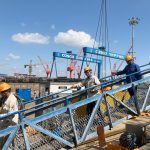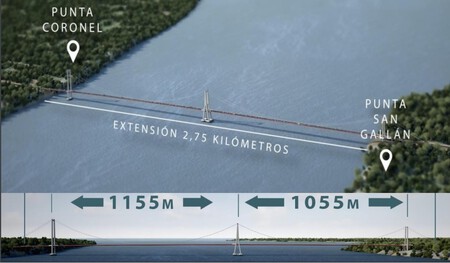He Chacao Bridge It aspires to become one of the great constructions in Chile and the largest suspension viaduct in Latin America, but there is a merit that has been earned even before its planned premiere —if nothing goes wrong— by the end of 2025: to be part of that select club of infrastructures with a story worthy of the best Follett novels. Just like the Messina viaduct, the Strait of Gibraltar tunnel or the Bridge of Peace. Let’s review. The project has been on the table since the 1960s, a long period during which it has experienced acceleration and braking, arousing enthusiasm and also misgivings.
Now at last it takes shape to make history.
What is the Chacao Bridge? A project, for now. Although it already takes shape. The objective –details the Chilean Ministry of Public Works— is to build a suspension bridge 2,750 meters long over the Chacao Channel, at South of that country. The viaduct will link the mainland and the Isla Grande de Chiloé. The structure will have three vertical reinforced concrete pillars of 157, 175 and 199 meters and two main spans of 1,055 and 1,155 m, in addition to those located on the sides. According to has detailed the ministry itselfwill exceed 50 meters in height.
Once it is opened, the viaduct will have four traffic lanes, which will allow crossing the Chacao Channel throughout the year with a car trip of just three minutes. It’s not bad if you take into account that to cover that gap now you need to invest about half an hour and get on a ferry. The complete project includes a service area and accesses, so 13.8 kilometers.


Because it is important? For its social impact, above all. “It will have a direct impact on the interaction of the island with the rest of the territory, allowing a greater development of its economic, educational, access to health, as well as tourist and socio-cultural activities,” I was reflecting on 2015 the then Undersecretary of Public Works. Beyond this value, the economic impact of the viaduct works themselves stands out: the total investment would be around 772 million dollars and, at least at the beginning of 2022, they worked in them a thousand people.
Will it be the largest in Latin America? This is claimed by the Chilean authorities, who assure that it will be the most extensive of its kind in the entire region. The nuance is important, since in South America there are other wider viaducts with other configurations, such as the Rio-Niteroi, in Brazil, 13.3 kilometers; the cable-stayed bridge General Rafael Urdaneta, of about 8.7 km, in Venezuela; or the Libertador General San Martinwhich connects Uruguay and Argentina reaching 3.4 km.
“With 2.7 km, it is the longest suspension bridge in Latin America, capable of resisting more than 12,000 vehicles circulating on its four lanes and with a useful life of 100 years. It is expected that when it comes into operation, the daily flow will increase from 3,000 to 5,500 cars a day”, highlighted the Government of Chile a year ago, after a visit by President Piñera to the works. The administration also left a couple of pieces of information: it is built with reinforced concrete and more than 40,000 tons of reinforcing and structural steel, five times the weight of the Eiffel Tower.
At what point is it? In action. And with the purpose of being ready before 2026. At least that is how they reflect it the latest information posted by The Mercurywhich details that in recent months the works have experienced significant progress: they would already be at 42.7% execution, well above the 31% that they marked in November by 2022. The north pier would already be visible and the goal would be for the infrastructure to be completed by the end of 2025.
And how are the works progressing? This same week the fiscal inspector of the concession, Carlos Castilla, recognized BNamericas that the works are advancing subject to a “very tight” schedule that complicates that it could be before November 2025, the date set in the concession. “Parts may be delayed, a ship may be capsized by a storm, anything may happen in the next two years,” he acknowledges. Work is also advancing in a channel marked by its adverse climate, in which strong gusts of wind and rain are not uncommon.
In any case, the works are advancing to make an initiative a reality that already seemed to be on the verge of leaping from the drawers into reality in the 1970s, late 1990s and early 2000s, only to end up frustrated in the process. At least until in 2013 it was launched a new tender which attracted the interest of an international consortium consisting of OAS, Systra, Aas-Jakobsen and Hyundai. Since then his chronicle has not been exempt from ups and downs and revisions of both the project and its calendar. You know: no one said that shaping a record-breaking mega-infrastructure was a simple or fast task.
In Xataka: Traveling 1,800 kilometers in a bullet train under the sea: the amazing proposal for the Emirates-India underwater tunnel
Images: Ministry of Public Works of Chile (YouTube) and Chamber of Deputies and Deputies















